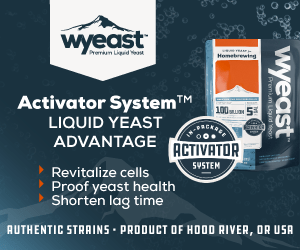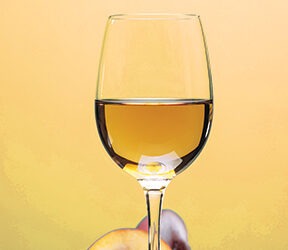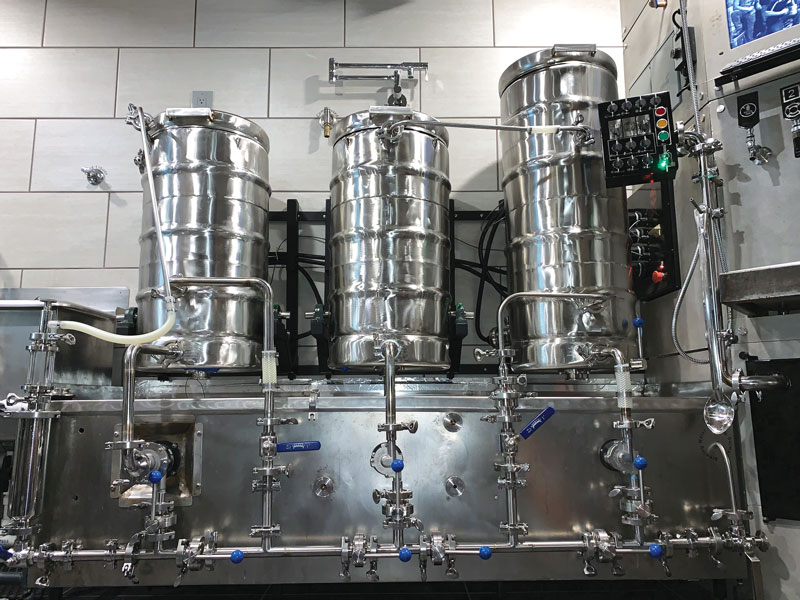Hard Seltzer
Hard seltzer
5.25 gallons/20 L
OG = ~1.031 FG = ~1.000
ABV = ~ 5%
Neutral Base Ingredients
21 L reverse osmosis (RO) or distilled water
4.5 g gypsum (adjusts calcium concentration to 50 ppm)
1.65 kg cane sugar
11.5 g packet SafAle US-05 or other neutral yeast strain
2.5 g Yeastex 82 yeast nutrient added with yeast pitch
2.5 g diammonium phosphate (DAP) added with yeast pitch
2.5 g Yeastex 82 yeast nutrient added 36–48 hours after yeast pitch
2.5 g diammonium phosphate (DAP) added 36–48 hours after yeast pitch
Flavorings
2.8 mL lime extract added after CO2 bubbling (if used) and carbonation
2.8 mL lemon extract after CO2 bubbling (if used) and carbonation
420 mL pulp-free orange juice (single-strength, not from concentrate) after CO2 bubbling (if used) and carbonation
14 g citric acid powder after CO2 bubbling (if used) and carbonation
Step by step
Add water and sugar to kettle, turn on heat, and stir to dissolve sugar. Check solution strength and adjust as necessary; the pre-boil gravity should be ~1.031 OG (7.6 °Plato). Continue heating until solution is boiling and boil for 20 minutes. Check solution strength and dilute as necessary with RO or distilled water. Cool to 64 °F (18 °C) and transfer to fermenter. Add yeast and first addition of nutrients. Aeration is not required for first use of most dried yeast strains, including US-05, due to high glycogen content related to propagation conditions (https://fermentis.com/en/tips-n-tricks/questions-and-answers/). Feel free to aerate as normal if this suggestion seems too unusual. Other common yeasts that are popular for seltzer production are Champagne yeast and distillers yeast.
Fermentation should begin within about 12 hours. The second nutrient addition is added once fermentation has really kicked off and the gravity has dropped by about 0.008 OG; this should be about 36–48 hours after yeast pitching. When fermentation is complete (5–7 days after yeast pitch — FG will depend on yeast and nutrients but should be around 1.000), cool to 32 °F (0 °C) (or as cold as possible at home) and hold cold to permit yeast sedimentation.
Commercially-produced seltzers are clarified by filtration and/or centrifugation, but most homebrewers do not have filters. Part of the seltzer appeal is clarity, therefore, filtration is recommended when going for a facsimile of the real McCoy. The good news is that hard seltzer is easy to clarify using a cartridge filter. But you could also go the Cloudy Claw route and skip this step. Whatever you decide with respect to filtration, transfer the seltzer into a keg and carbonate to 2.8–3.0 volumes. Bottle or keg conditioning is not typical for hard seltzer. Taste the seltzer base to determine if aroma stripping is needed.
Sulfur off-flavors are fairly common with hard seltzers. Carbon dioxide bubbling can be used to strip these unpleasant rotten-egg and burnt-match aromas from hard seltzer. Just make sure to vent the keg during bubbling to allow these volatiles to escape. Nutrient adjustments and/or yeast strain selection on future batches can be made to help dial in the process. The trial and error nature of this process is the primary reason that many commercial seltzer producers select a yeast/nutrient blend designed for these intentionally bland bases.
The last step is to add the flavor additions. Dissolve the citric acid powder in the orange juice and add it along with the lemon and lime aromas. Slowly release the pressure on the keg, open the top while flushing the headspace with CO2, and add the flavorings. Quickly closing the lid and re-pressurizing the headspace will minimize loss of carbonation. The orange juice in this recipe is intended to provide a slight haze, so if you choose not to filter, the juice will complement the haze of the seltzer.
Written by Ashton Lewis




